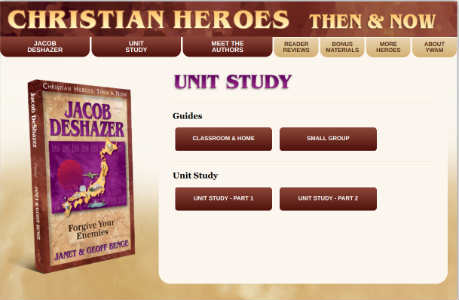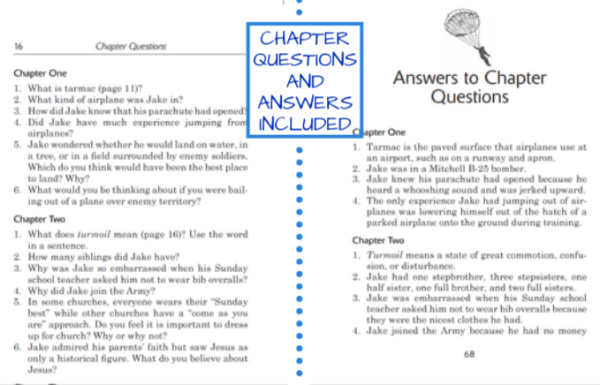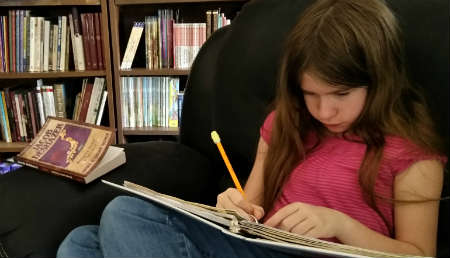I really enjoy using resources from YWAM Publishing and was excited to have the opportunity to review of one of their Christian Heroes: Then & Now biographies. When I first skimmed through list of books we could review, it was tough to choose one. A book that capitalized on my twins daughters’ interest in Japan would be perfect, but could I find one?

I had heard of most of the heroes before, but several were new to me. I clicked on an unfamiliar name—Jacob DeShazer—and read a summary of his life. I knew at once that my girls would enjoy learning about him since he was a missionary to Japan. When I mentioned the biography to them, they could not wait to review Jacob DeShazer: Forgive Your Enemies. YWAM Publishing sent us a digital Study Guide to accompany the book.

Upon receiving the biography, I read through it myself before handing it off to the girls. I travelled back in time to World War II and learned that Jacob DeShazer was one of the Doolittle Raiders who dropped the first US bombs on Japan. I was surprised to find that even though Jake grew up in a Christian family, he rejected the Christian faith. Only after being captured and imprisoned by the Japanese did he come to trust Jesus as his Savior.
After the war was over and Jake was released, God gave him such a love for the Japanese people that he wanted to return there to share the gospel. He attended Bible college, prepared to be a missionary, and traveled to Japan, reaching many spiritually hungry Japanese people with the great news of forgiveness through Jesus.
I loved reading the book for myself and could hardly wait to share it with the twins, but first I needed to plan our lessons.

When I first glanced through the pages of the unit study guide, it was overwhelming. There are so many suggestions and ideas that no one could possibly do all of them. Of course, that is how unit studies usually work. Do I have to sample every item on the buffet at an all-you-can-eat restaurant? Of course not! We did not have to use every idea in the study guide either.
Since we have not explored much literature this year, we used the book primarily as an English unit. We focused primarily on the reading and comprehension questions in the study guide. Disappointed that there were not worksheets for the questions, I set about making my own, which I printed for the twins to fill in. Copying and pasting from the digital study guide made this process pretty simple, but it would have been nice if comprehension worksheets had been provided.

Each day, the girls eagerly read one or two chapters of DeShazer’s story and wrote out the answers to the six questions for each chapter. The first one was always a vocabulary question. Questions two through four helped the girls demonstrate their comprehension. The final two questions required them to think more deeply and consider parallels between their own lives and Jacob DeShazer’s. Answers to all of the factual questions are included near the end of the study guide. Rather than grade the girls’ work, we discussed their answers aloud after they had written them out.
I was glad that the study guide recommends several video resources, since all my kids love a good movie. I was able to locate a couple of the suggestions online through services I already use, like Amazon Prime and SchoolhouseTeachers. We watched a video about Japanese culture near the beginning of our study. As we progressed through the books, we watched a three-part video about Jacob DeShazer. We used blank outline maps from the study guide to mark key locations in Jacob’s life.

The Study Guide suggests many ideas we did not use. Families who have time to delve deeper and assign projects or writing assignments will find plenty of ideas. The guide also includes suggestions for for making a display of items related to Jacob DeShazer’s life. A chapter called “Community Links” offers field trip ideas. The guide even proposes memorable ways to wrap up the study.
We concluded our study of Jacob DeShazer the way we often do with products we are reviewing—I asked the twins what they thought about it.
An Interview with the Twins

“What did you think of the book?”
“It was really fun to every day learn more about Jake,” responded the older girl.
“I like how everything was written in great detail,” added her sister. “It talked a little bit about all of the important people in the story—all of the people…all of the crew of The Bat” (the plane on which Jake was a bombardier in World War II).
“The best thing is that it was centered in Japan, and I love Japan!”
“He has interesting life experiences!”
”Did you appreciate the discussion questions?”
The younger one commented, “I liked how they gave us a greater idea of what was happening. Because we put our thoughts together… that gave us a better idea of what was happening.”
“It made me remember more.”
“The final two questions in each chapter were designed to make you think more deeply. Do you think they were helpful?”
According to the older girl, “They made me question parts of my life that I would normally not think of, so it was a bit hard, but in a good way.”
“They helped me to know myself better,” added her twin.
“I learned how much extreme pain Jake went through and …I realized how much pain many soldiers would go through by knowing how much pain he had.”
The Importance of Christian Biographies
Do you want your children to love learning about history and the world around them? Is one of your goals for them to grow in their Christian walk? Are you looking for ways to inspire them to stand boldly for the Lord? Incorporating the biographies of Christian heroes in your homeschool can help.

I highly recommend the biographies and study guides from YWAM Publishing. Whether you choose to learn about Jacob DeShazer, C.S. Lewis, Corrie Ten Boom, or any of the other forty-something Christian Heroes in YWAM’s series, studying the lives of heroes of the faith inspires our children to learn and think globally, grow strong spiritually, and stand firm in the faith.
